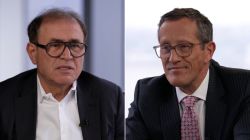A version of this story first appeared in CNN Business’ Before the Bell newsletter. Not a subscriber? You can sign up right here. You can listen to an audio version of the newsletter by clicking the same link.
Federal Reserve Chair Jerome Powell is on the hot seat this week as he testifies before Congress. Investors will be watching closely as they search for signs of future rate hikes.
Powell is expected to speak before the Senate Banking Committee on Tuesday morning and the House Financial Services Committee on Wednesday. During these testimonies, he’ll be tasked with convincing lawmakers that the central bank is capable of bringing down inflation without crashing the US economy in its wake.
Powell will have some good news to report — when he last testified before Congress in June, the inflation rate was at 40-year-highs, nearing 9%. Today, that rate has dropped to 6.4%, though it remains well above the Fed’s annual target of 2%. Year-over-year inflation has declined for seven consecutive months.
Still, some in Congress have been openly critical of the Fed’s efforts to cool the economy through painful interest rate hikes. Investors will also be on edge — hawkish language or even an aggressive tone from Powell could lead to market volatility.
Here are three things to watch for in this week’s testimony:
The state of the economy
Is the US economy heading towards a recession or not? It’s the question on most economists and investors minds.
Many Fed officials have admitted that they themselves are baffled by the current economic readout: Data signal a rip-roaring labor market, high home prices and strong US consumers but the decline in inflation has stalled and prices remain elevated.
The economy has become seemingly impervious to a string of large interest rate hikes by the Fed, and investors are waiting to see how much longer it can hold up.
“The inflationary forces impinging on the US economy at present represent a complex mixture of temporary and more long-lasting elements that defy simple … explanation,” said Fed Governor Philip Jefferson at a conference late last month.
So how will Powell answer questions about something that defies “simple” explanation? We’ll soon find out.
Rate hikes
The most pressing piece of information investors are looking for is how high the Federal Reserve will hike interest rates later this month and whether central bank officials expect to pivot away from their painful interest rate increases in the near future.
Former Treasury Secretary Larry Summers said on CNN Monday that the Fed will likely have to return to larger rate hikes to stave off inflation as the economy continues to grow.
“I don’t think there’s any question that we do not yet have inflation on a secure glide path anywhere near down to the 2% [Fed target] level,” Summers said. “And until the Fed can be confident of that, it’s going to have to be tightening rather than easing.”
Summers said his best guess would be for the Fed funds rate to rise from its current range (4.5% to 4.75%) to 5.5%, but noted he “wouldn’t be amazed” if it were to hit 6%, given the uncertainties in the economy.
“Hope for the best but plan for the worst, I think is the right advice,” Summers said.
Some Fed officials agree. On Saturday, San Francisco Federal Reserve President Mary Daly said that she believes there’s more work to do to bring down inflation. “In order to put this episode of high inflation behind us, further policy tightening, maintained for a longer time, will likely be necessary.”
So will Powell join in and signal that more rate hikes are on their way?
Inflation goals
The United States is still a long way off from the Federal Reserve’s 2% inflation goal and economists have warned that it could take years to get there as the price increases appear to be crab walking instead of deflating.
The stickiness of inflation has caused some economists to question whether 2% is still the correct goal.
“The path back to target inflation could prove to be longer than hoped, particularly with limited progress in the Fed’s goal of creating some slack in labor market conditions,” said Jim Baird, chief investment officer of Plante Moran Financial Advisors.
Powell has been steadfast in his devotion to that 2% goal but expect some lawmakers to question him on whether he’d accept potentially sinking the stock market or tanking the economy to get there.
More economic confusion
JPMorgan Chase CEO Jamie Dimon, who is fond of reporting the economic weather, is also baffled by the state of the US economy.
When asked about his economic outlook by Bloomberg Television in an interview Monday, he presented a menu of options. “We could still have a soft landing,” he said. “A mild recession is possible, a harder recession is possible,” he said.
The remarks seem to hit the nose of the general economic outlook. Economists, business leaders, investors and even Fed officials aren’t really sure about what’s happening.
Even the Oracle of Omaha himself, Warren Buffett, recently wrote in his annual letter to Berkshire Hathaway shareholders that he and business partner Charlie Munger “firmly believe that near-term economic and market forecasts are worse than useless.”

























